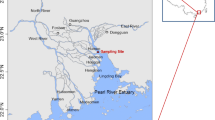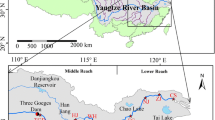Abstract
The survey of polycyclic aromatic hydrocarbons (PAHs) and their relation to potential pollution sources were investigated in suspended particulate matter (SPM), surface waters, and sediments from Elelenwo Creek, southern Nigeria. Total PAH concentrations varied from 2,021.35 to 3,926.84 μg/kg dry weights in SPM and from 4,238.00 to 5,490.84 μg/kg dry weights in sediments. Furthermore, concentration levels of PAHs varied from 720.46 to 857.65 μg/l in the surface waters, which indicates that the aquatic ecosystem is polluted by PAHs. The 2, 3-ring PAHs were not dominant in SPM (34.73%), surface water (40.09%), and sediments (22.43%). While anthracene was more abundant, of the 2, 3-ring PAHs in SPM, the most abundant in the surface waters and sediments were fluorene and acenaphthylene. Four origin indices or concentration ratios of PAH isomer pairs were used to evaluate the suitability of these compounds as tracers to distinguish between the contamination arising from different sources. A critical appraisal of the PAH indices, therefore, suggested that biomass combustion is the major PAH source in the environmental matrices. Relative PAH patterns in the environmental matrices were also evaluated using principal component analysis, and were found to correlate with the PAH patterns of the different potential contamination sources.



Similar content being viewed by others
References
Cerniglia CE (1992) Biodegradation of polycyclic aromatic hydrocarbons. Biodegradation 3:351–368
Countway RE, Dickhut RM, Canuel EA (2003) ‘Polycyclic aromatic hydrocarbon (PAH) distributions and associations with organic matter in surface waters of the York River’, VA Estuary. Org Geochem 3:351–368
Harvey RG (1996) Polycyclic aromatic hydrocarbons. Wiley, New York, pp 8–11
Hites RA, Laflame RE, Farrington JW (1997) Sedimentary polycyclic aromatic hydrocarbons-historical record. Science 198:829–831
Meglen RR (1992) Examining large databases: a chemometric approach using principal component analysis. Mar Chem 39:217–237
Okafor EC, Opuene K (2007) Preliminary assessment of trace metals and polycyclic aromatic hydrocarbons in the sediments of Taylor Creek, Southern Nigeria. Int J Environ Sci Tech 4(2):233–240
Opuene K (2005) Water quality parameters, levels and impacts of heavy metals and polycyclic aromatic hydrocarbons in Taylor Creek aquatic ecosystem, Niger Delta. PhD Thesis, Department of Pure and Industrial Chemistry, University of Nigeria
Prahl FG, Carpenter R (1983) Polycyclic aromatic hydrocarbon (PAH)–phase association in Washington coastal sedimentary particulates from Dadob Bay, Washington DC. Geochim Cosmochim Acta 47:463–472
Vrana B, Paschke A, Popp P (2001) Polyaromatic hydrocarbon concentrations and patterns in sediments and surface water of the Mansfeld region, Saxony-Anhalt, Germany. J Environ Monit 3:602–609
Witt G (1995) Polycyclic aromatic hydrocarbons in water and sediments of the Baltic Sea. Mar Pollut Bull 31:1139–1149
Xiao-Jun L, She-Jun C, Bi-Xian M, Qing-Shu Y, Guo-Ying S, Jia-Mo F (2006) Polycyclic aromatics hydrocarbons in suspended particulate matter and sediments from the Pearl River Estuary and adjacent areas. Chin Environ Pollut 139:9–20
Young LY, Cerniglia CE (1995) Microbial transformation and degradation of toxic organic chemicals. Wiley, New York
Yunker MB, Macdonald RW, Vingazan R, Mitchell RH, Goyette D, Sylvestre S (2002) PAHs in the Fraiser River Basin: a critical appraisal of PAHs ratios as indicators of PAH source and composition. Org Geochem 33:489–515
Zar JH (1996) Biostatistical analysis. Prentice-Hall, Upper Saddle River, p 662
Zhou JL, Maskaoui K (2003) Distribution of polycyclic aromatic hydrocarbons in water and sediments from Da Ya Bay, China. Environ Pollut 121:269–281
Author information
Authors and Affiliations
Corresponding author
Rights and permissions
About this article
Cite this article
Opuene, K., Agbozu, I.E. & Adegboro, O.O. A critical appraisal of PAH indices as indicators of PAH source and composition in Elelenwo Creek, southern Nigeria. Environmentalist 29, 47–55 (2009). https://doi.org/10.1007/s10669-008-9181-5
Received:
Accepted:
Published:
Issue Date:
DOI: https://doi.org/10.1007/s10669-008-9181-5




